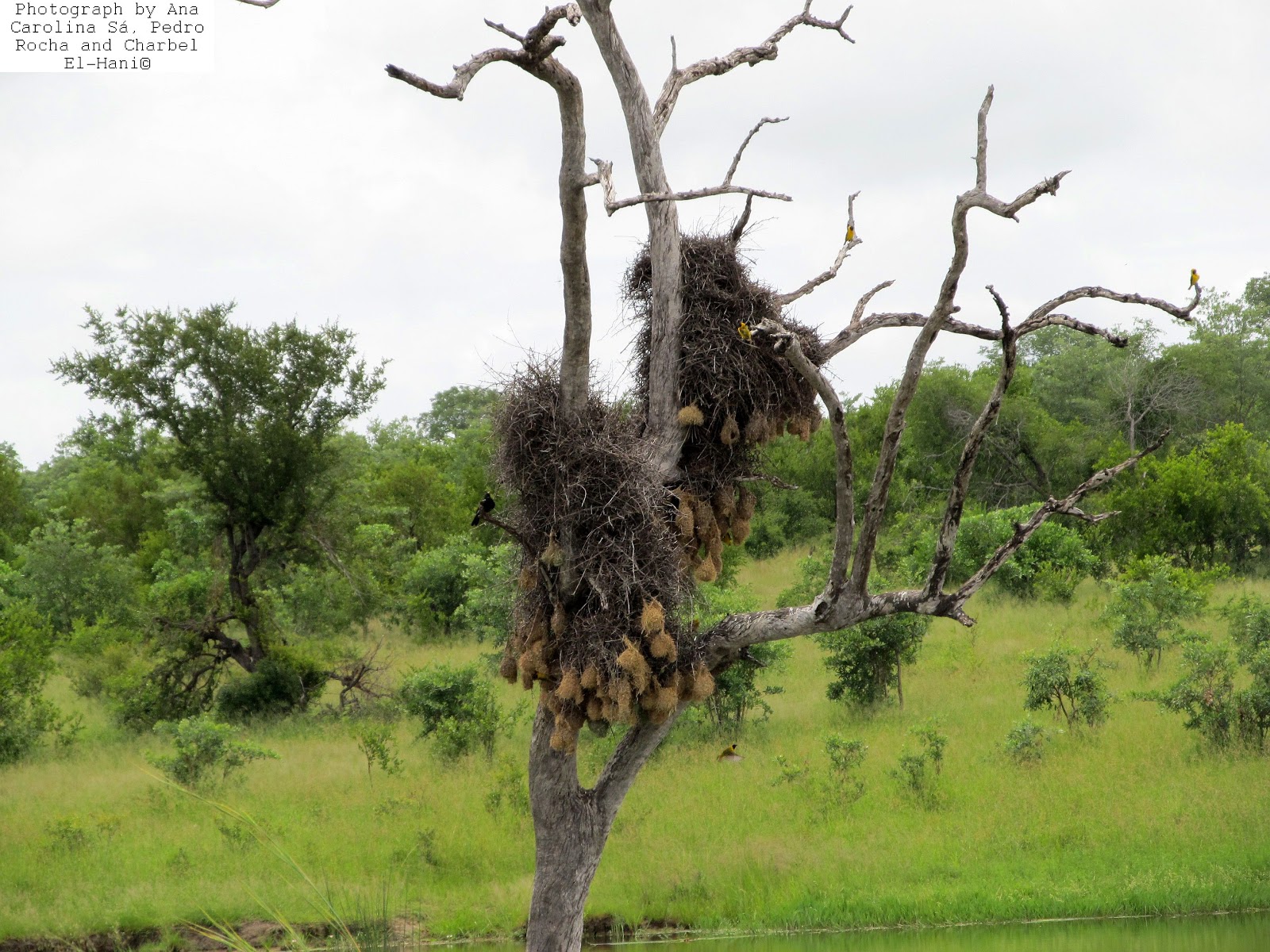Uma coisa maravilhosa de se ver no reservatório foi a árvore no meio dele com uma grande colônia de Tecelões-pequenos-de-mascarilhas.
Nas duas imagens abaixo podemos ver a colônia inteira e um detalhe. Na primeira imagem, há uma outra ave na árvore. Eu só a vi agora, ao preparar a postagem do blog. É realmente excitante descobrir que fotografamos uma ave que nós nem havíamos notado. É um Drongo-de-cauda-forcada. Além disso, vocês certamente podem ver as estruturas enormes acima dos ninhos dos tecelões. São provavelmente ninhos de Hamerkops.
Tecelões-pequenos-de-mascarilhas são aves charmosas, não?
Uma coisa incrível foi lembrar, quando estava lá observando os teceções, como eu era fascinado com os tecelões (que eu conhecia apenas de meus livros) quando eu era criança. Eu havia esquecido dessas memórias antigas da infância e foi realmente sensacional lembrar subitamente delas, ali naquele ponto, observando essas aves que eu havia esquecido de que gostava tanto. É muito bom saber, então, que elas não estão ameaçadas: Least Concern ma Lista Vermelha da IUCN, com populações estáveis.
O que me fascinava nessas aves (e provavelmente irá fascinar muitos de vocês) é a delicada arquitetura de seus ninhos, lado a lado com o tamanho da colônia. Esta é uma espécie polígina, com machos procriando com múltiplas fêmeas durante a estação reprodutiva. Eles vivem juntos em colônias com 20-30, raramente até 200 ninhos. Neste caso, contamos 35 ninhos. É o macho que constrói o ninho e é um trabalho duro. Eles ficaram todo o tempo reparando os ninhos enquanto estávamos ali. Eu adoro o formato de rim do ninho e o túnel de entrada voltado para baixo!
Tecelões-pequenos-de-mascarilhas também são caçados por Águias Pescadoras Africanas. Mas o que a águia estava caçando? A resposta é Patos-assobiadores-de-faces-brancas. Nós quase obtivemos uma foto das águias caçando os patos, mas eles desceram exatamente no momento da foto e capturamos apenas a parte superior de seus corpos. De qualquer modo, foi demais seguir a ação.
Que bela ave é a Águia Pescadora Africana. Elegância ao máximo!
Também Least Concern na Lista Vermelha da IUCN, com população estável, esta águia foi observada por nós várias vezes durante a viagem. Mas esse encontro na Transport Dam foi o mais impressionado, com a ação de caça.
Mitos sobre a Águia Pescadora Africana são muitos. Na herança cultural Shona, esta águia era um mensageiro sagrado, usado pelo Rei para comunicar-se com os ancestrais. Ela é também o totem do clã Hungwe e se tornou símbolo do estado de Zimbabwe, aparecendo na bandeira nacional e em notas e moedas, desde que Zimbabwe se tornou independente em Abril de 1980.
Para terminar, os waterbucks nos propiciaram algumas imagens comportamentalmente interessantes,embora estivessem distantes, do outro lado do reservatório. Vejam como uma das fêmeas, que estava deitada com as outras duas, se levantou e emitiu um chamado.
Então ela se moveu na direção de um arbusto próximo…
E encontrou um outro waterbuck. Notem como ela é menor. Provavelmente, mãe e filha.
In the first two pictures we can see
the whole colony and a detail of it. In the first picture, there is another
bird in the tree. I just saw it now, when preparing the posting. It is really
exciting to discover we photographed a bird we did not even notice back then.
It is a Fork-Tailed Drongo. Moreover, we certainly see the huge structures
about the weaver’s nests. They are probably hamerkop’s nests.
Lesser Masked Weavers are charming
birds, aren’t they?
One incredible thing was to
remember, when I was there watching the weavers, how fascinated I was with
weavers (which I knew only from my books) as a small child. I had forgotten
these remote childhood memories, and it was really something to suddenly
remember it on the spot, watching these birds I had forgotten I loved so much.
It is great to know, then, that they are not threatened: Least Concern in the
IUCN Red List, with stable populations.
Lesser Masked Weavers are also hunted by African-Fish Eagles. But what was the eagle hunting? White-faced
ducks, that’s the answer. We almost got a picture of the eagles hunting the ducks, but they went down exactly when we were taking the picture and
we captured only the upper part of their bodies. Anyway, it was great to
follow the action.
What a beautiful bird the
African-Fish Eagle is. Elegance at its outmost!
Also Least Concern in the IUCN Red
List, with stable population, this eagle was observed by us several times
during the trip. But this encounter in Transport Dam was the most impressive
one, with the hunting action.
Myths also surround the African-Fish
Eagle. In the Shona cultural heritage, this eagle was a sacred messenger, used
by the King to communicate with the ancestors. It is also the totem of the
Hungwe clan and has been the symbol of the Zimbabwe state, appearing on the
national flag and on bank notes and coins, since Zimbabwe became independent in
April 1980.
The waterbucks, to finish, gave us
some behaviorally interesting pictures, even though they were far away, at the
other side of the dam. Look how one of the females, which was laying down with
the other two, raised up and called.
Then she moved to a nearby shrub…
And found another waterbuck. Notice how she is smaller. Mother and daughter, probably.










Nenhum comentário:
Postar um comentário